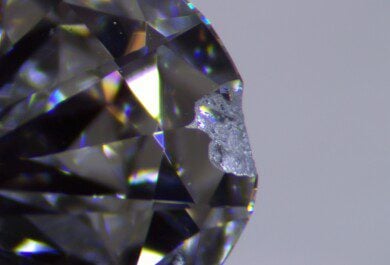There are two major Gems and Gemology articles relating to inclusions in Gems & Gemology, both primarily concerned with “black” diamonds.
G&G Winter 1990: An Investigation of a Suite of Black Diamond Jewelry p.282-p.287
Robert C. Kammerling, Robert E. Kane, John I. Koivula, and Shane F. McClure
and
G&G Fall 2003: An Investigation into the Cause of Color in Natural Black Diamonds from Siberia
While the literature does talk about “graphite” inclusions in colorless diamonds, many assume that “black” inclusions in diamonds are all “carbon (graphite) “, the only thing scientifically reaonable to say is that not all “black” appearing inclusions are in fact graphite, and may be other minerals which may appear “black”, dependent on the lighting technique used under a microscope. High relief inclusions may generally appear black under darkfield, but when subjected to fiberoptic oblique lighting, may in fact be a deep color, (red, green) other than “black” with luster other than what would be characteristic of “graphite”, and may be in fact bet garnet, zircon, peridot or any of a host of other minerals associated with dimondiferous host rocks.
The Fall 2003 G&G article is the one of the most technical in the current gemological literature, and deals with “Siberian” blacks, which are seemingly highly included diamonds whose primary inclusions are magnetite, hematite or native iron. But it only goes to reason and common sense, that there are also Siberian colorless diamonds containing less dense and/or minute concentrations of these same Iron related materials.
“Graphite” or other forms of carbon inclusions occur naturally in diamonds, and it is also known that “graphitization”, both externally and internally, may be also induced by High Pressure High Temperature treatments.
As to the technical literature, even a simple search would lead one to say that any “jeweler” who claims that the “black” inclusion in your diamond is automatically “graphite”, doesn’t know what he or she is talking about, period,, and is just a merchant trying to impress you with smoke and mirrors.
A quick search of the literature on http://www.scholar.google.com using the search “black inclusions in diamond” turns up over 3000 technical articles, which I think serves to make my point. (Some of these articles are free but most link to abstracts in “peer reviewed” journals where the cost of each total article is typically $30 to $50, a current bone of contention in acedemic and research circles, however there are quite a few pdfs that are available free of charge.)
There is no one answer, other than emphatically saying that not all “black” appearing inclusions are forms of carbon (or are graphite).











